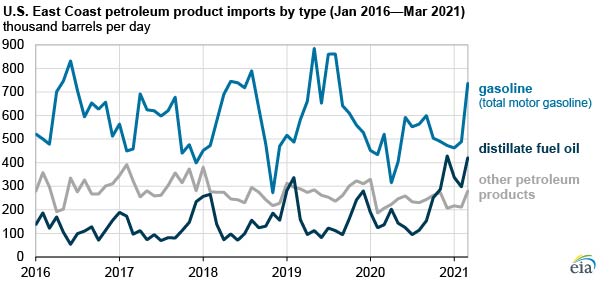
Imports of petroleum products—gasoline, distillate, and other products—into the East Coast region of the United States increased in March 2021. Rising imports resulted from lower domestic supply, higher demand, and higher domestic petroleum product prices compared with prices in Europe. In March, East Coast petroleum product imports averaged 1.4 million barrels per day (b/d). In addition, East Coast gasoline imports averaged 737,000 b/d, the highest March level since 2009, and East Coast distillate imports averaged 421,000 b/d, the highest March level since 2003.
Petroleum product imports into the East Coast region increased primarily for three reasons.
First, domestic supply was reduced, due in part to the extreme winter weather in February 2021, which disrupted operations at several refineries in the U.S. Gulf Coast region, where more than half of U.S. refinery capacity is located. Because significantly more petroleum products are consumed in the East Coast region than its regional refineries produce, the region relies on imports and pipeline supplies from the U.S. Gulf Coast region.
When production is disrupted in the U.S. Gulf Coast region (as was the case in February and March 2021), the East Coast region relies more on imports to meet its petroleum product demand. Lower supply, particularly in the East Coast region, has also been due, in part, to lower East Coast refining capacity after the 335,000 b/d Philadelphia Energy Solutions (PES) refinery closed in June 2019. We estimate that closing the Philadelphia refinery reduced East Coast gasoline supplies by approximately 160,000 b/d and distillate supplies by approximately 100,000 b/d.
Second, domestic demand for petroleum products increased. U.S. gasoline consumption increased to 8.6 million b/d in March, the highest level since February 2020, and distillate consumption increased to 4.0 million b/d, the highest level since November 2019.
Third, the prices of U.S. petroleum products have been higher than in Europe. In March, the New York Harbor gasoline spot price averaged 30 cents per gallon (gal) more than gasoline in Europe, the widest spot price spread between these markets in the past 10 years (2012–2021).
The New York Harbor spot price for ultra-low sulfur diesel (ULSD), which is a subset of distillate, averaged 19 cents/gal more than the spot price for Europe’s gasoil (the name for ULSD in Europe) in March and has been more than 10 cents/gal higher than Europe’s gasoil spot price since November 2020.
In warmer months, distillate demand typically decreases as a result of less heating demand, while gasoline demand typically rises because of more driving in the summer. According to our Weekly Petroleum Status Report data, distillate imports into the East Coast region averaged 208,000 b/d from April 2 through June 4, and gasoline imports averaged 816,000 b/d.

Follow us on social media: